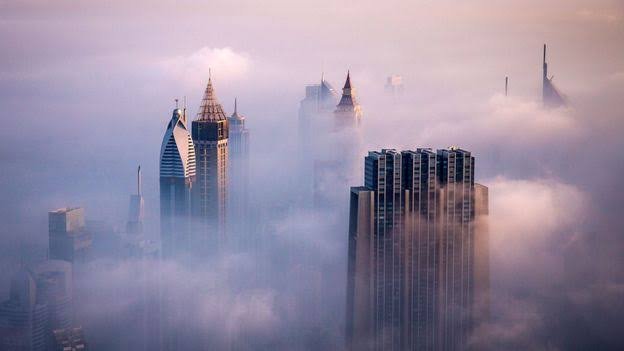The UAE, renowned for its sprawling deserts, modern skyline, and consistently sunny weather, is also occasionally subject to a natural phenomenon that contrasts with its typical climate: fog. Although fog is more commonly associated with cooler, temperate climates, the UAE experiences this intriguing weather event several times throughout the year, especially during the cooler months. Fog in the UAE is more than just a brief inconvenience; it plays a significant role in shaping daily life, influencing transportation, safety protocols, and even the country’s environmental initiatives.
This article delves into the phenomenon of fog in the UAE, examining how it forms, the challenges it presents, and its impact on the region’s environment and infrastructure.
What is Fog?
Fog is a collection of tiny water droplets suspended in the air near the ground, which reduce visibility. It forms when the air near the surface cools to a point where moisture condenses, typically during the night and early morning hours. Fog is most common in areas with high humidity, and it is often seen in places near large bodies of water, such as lakes, rivers, and oceans, or in regions where temperature inversions occur.

While fog is typically associated with cooler climates, the UAE’s proximity to the Arabian Gulf, its coastal regions, and unique climatic conditions create an environment where fog can form, albeit sporadically.

When Does Fog Occur in the UAE?

The UAE’s desert climate is characterized by hot, dry summers and mild winters, with temperatures dropping significantly at night. However, during the winter months, especially from November to March, the country can experience periods of high humidity, which combined with the cooler nighttime temperatures, creates the perfect conditions for fog to form.
Fog in the UAE is most likely to occur during the early morning hours, when the drop in temperature leads to condensation. It can form quickly, enveloping the landscape in a thick blanket that can last for several hours. The presence of large bodies of water, such as the Arabian Gulf, also plays a significant role in fog formation. Coastal areas, such as Dubai and Abu Dhabi, are more prone to foggy conditions than inland regions.
The phenomenon is more frequent in the northern and coastal parts of the UAE, where higher humidity levels are present. However, fog can also occasionally affect inland cities like Al Ain and parts of the desert, though it is less common there.
Types of Fog in the UAE
The UAE experiences different types of fog, which can vary in intensity and duration. These include:
- Radiation Fog: This is the most common type of fog in the UAE and occurs when the ground cools rapidly at night, causing the moisture in the air near the surface to condense into fog. This type of fog is usually thick and forms mainly in low-lying areas.
- Advection Fog: This fog forms when warm, moist air moves over a cooler surface, leading to condensation. In coastal areas of the UAE, this type of fog can occur when humid air from the Arabian Gulf moves inland over the cooler desert terrain.
- Valley Fog: In areas with valleys or depressions, such as parts of Al Ain, fog can form in the early morning when cooler air settles in the lower areas. This type of fog tends to persist longer than radiation fog and can be particularly dense.
- Sea Fog: This occurs when cooler air from the land moves over warmer waters, leading to condensation. It is more common in the coastal areas of the UAE, particularly around Dubai and Abu Dhabi.
Challenges Posed by Fog in the UAE
Although fog can be a beautiful spectacle, it brings with it a range of challenges that the UAE must address, particularly in terms of safety and transportation. The impact of fog on the country is multifaceted, affecting everything from road traffic to air travel, and even the energy sector.
- Road Safety and Traffic Disruptions: The most immediate and visible impact of fog in the UAE is on road traffic. Visibility can drop significantly in foggy conditions, sometimes to just a few meters, which increases the risk of accidents. The UAE, known for its bustling roads and high-speed highways, faces particular challenges during foggy mornings, with frequent traffic accidents and delays occurring on major roads like Sheikh Zayed Road, Emirates Road, and the roads connecting the northern emirates.
The authorities have taken proactive measures to address these challenges. For example, the Dubai Police often issue advisories when fog is predicted, warning drivers to reduce speed and maintain safe distances from other vehicles. In some cases, roads are temporarily closed or redirected to prevent accidents. Fog lights on vehicles are also emphasized to ensure better visibility, though drivers are urged to avoid using high beams, which can reflect off the fog and create further visibility issues.
- Air Travel Disruptions: Fog can also affect air travel in the UAE, particularly at Dubai International Airport, one of the busiest airports in the world. When thick fog settles over the airport, it can lead to delays, cancellations, and diversions of flights. With low visibility, pilots may have difficulty navigating, especially during takeoff and landing. In some cases, flights may be grounded until the fog clears, leading to disruptions in the travel schedule.
Airport authorities have developed advanced weather tracking systems and fog detection technologies to mitigate the effects of fog on air travel. They work closely with airlines and air traffic control to ensure safety, often rerouting flights or rescheduling operations when visibility is compromised.
- Impact on Energy and Solar Power: The UAE is a leader in renewable energy, particularly solar power, and fog can pose challenges for solar energy production. Thick fog reduces the amount of sunlight reaching solar panels, resulting in a decrease in energy generation. This is especially noticeable during periods of prolonged fog, when solar energy systems may not operate at full capacity.
Despite these challenges, the UAE is committed to continuing its focus on renewable energy and has developed innovative solutions, such as incorporating energy storage systems that can store excess energy generated on clear days for use during cloudy or foggy periods.
The Role of Fog in the Environment
While fog may present certain challenges, it also has a positive impact on the environment. In the UAE, fog can act as a natural form of precipitation, especially during the cooler months. This condensation can be absorbed by the soil, providing moisture to plants and crops in areas where rain is scarce.
Additionally, fog plays a role in cooling the air temperature during the morning hours, providing temporary relief from the heat of the UAE’s desert climate. This cooling effect is particularly important during the warmer months, as it offers some respite from the intense sun and high temperatures.
Mitigating the Effects of Fog in the UAE
The UAE government continues to take steps to mitigate the effects of fog on daily life. This includes developing better weather forecasting and detection systems, improving infrastructure for safer driving conditions, and investing in technologies that allow for smoother transportation during foggy conditions. Moreover, educational campaigns aimed at informing the public about driving safely in fog are regularly conducted, helping to reduce accidents and fatalities.
Conclusion
Fog in the UAE, though a rare and temporary phenomenon, has a profound impact on the country. From creating traffic hazards to affecting air travel and solar energy production, fog presents unique challenges that require careful attention and management. At the same time, it adds to the richness of the natural environment, providing benefits such as moisture for plants and a brief cooling effect on the landscape.
As the UAE continues to grow and develop, the management of natural phenomena like fog will remain a key aspect of ensuring safety, sustainability, and smooth daily operations. With continued advancements in technology and infrastructure, the UAE is well-equipped to handle the effects of fog while maintaining its status as a global leader in innovation and development.
Do follow Uae stories for more Updates














